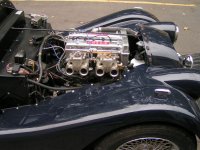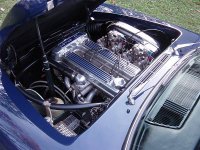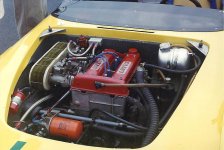eschneider
Jedi Warrior
Offline
Got a weird one.
Customer is finishing the cosmetic resto of a Lotus-powered Morgan (recently purchased, basically an "unknown" engine). After we re-gasketed and re-sealed and painted the engine, it is now spewing oil.
The oil was 3-4 quarts overfilled. Fixed that, but now there is very little pressure coming from the draft tube (vent from the right rear of the cylinder head), and very high pressure when the oil filler cap is removed.
we know the engine has loose rings (consensus is that this is the result of a race-spec engine rebuild from the 80's) - but this should have caused high crankcase pressures, and we have the reverse problem.
the car does smoke heavily when started. <edit> Loose valve guides wouldn't be exposed to combustion pressure, though - the valves are closed at that point. I don't think it's a cracked head or head gasket - compression and leakdown were low but equal on all cylinders.
why would there be such a differnce between crankcase and valve cover pressure? Aren't the two essentially the same given that the timing chain passage connects the top and bottom end of the motor?
There is also a profuse amount of oil under the valve cover with then engine running - is that normal?
edit - I did check for obstructions in the crank vent from the fuel pump cavity to the outlet at the head - compressed air blew though without apparent restriction.
Customer is finishing the cosmetic resto of a Lotus-powered Morgan (recently purchased, basically an "unknown" engine). After we re-gasketed and re-sealed and painted the engine, it is now spewing oil.
The oil was 3-4 quarts overfilled. Fixed that, but now there is very little pressure coming from the draft tube (vent from the right rear of the cylinder head), and very high pressure when the oil filler cap is removed.
we know the engine has loose rings (consensus is that this is the result of a race-spec engine rebuild from the 80's) - but this should have caused high crankcase pressures, and we have the reverse problem.
the car does smoke heavily when started. <edit> Loose valve guides wouldn't be exposed to combustion pressure, though - the valves are closed at that point. I don't think it's a cracked head or head gasket - compression and leakdown were low but equal on all cylinders.
why would there be such a differnce between crankcase and valve cover pressure? Aren't the two essentially the same given that the timing chain passage connects the top and bottom end of the motor?
There is also a profuse amount of oil under the valve cover with then engine running - is that normal?
edit - I did check for obstructions in the crank vent from the fuel pump cavity to the outlet at the head - compressed air blew though without apparent restriction.

 Hi Guest!
Hi Guest!

 smilie in place of the real @
smilie in place of the real @
 Pretty Please - add it to our Events forum(s) and add to the calendar! >>
Pretty Please - add it to our Events forum(s) and add to the calendar! >> 





